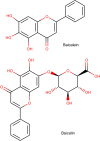Protective and therapeutic effects of Scutellaria baicalensis and its main active ingredients baicalin and baicalein against natural toxicities and physical hazards: a review of mechanisms
- PMID: 35870110
- PMCID: PMC9715893
- DOI: 10.1007/s40199-022-00443-x
Protective and therapeutic effects of Scutellaria baicalensis and its main active ingredients baicalin and baicalein against natural toxicities and physical hazards: a review of mechanisms
Abstract
Objectives: Scutellaria baicalensis (SB) has been traditionally used to combat a variety of conditions ranging from ischemic heart disease to cancer. The protective effects of SB are due to the action of two main flavonoids baicalin (BA) and baicalein (BE). This paper aimed to provide a narrative review of the protective and antidotal effects of SB and its main constituents against natural toxicities and physical hazards.
Evidence acquisition: Scientific databases Medline, Scopus, and Web of Science were thoroughly searched, based on different keywords for in vivo, in vitro and clinical studies which reported protective or therapeutic effects of SB or its constituents in natural and physical toxicities.
Results: Numerous studies have reported that treatment with BE, BA, or total SB extract prevents or counteracts the detrimental toxic effects of various natural compounds and physical hazards. The toxic agents include mycotoxins, lipopolysaccharide, multiple plants and animal-derived substances as well as physical factors which negatively affected vital organs such as CNS, liver, kidneys, lung and heart. Increasing the expression of radical scavenging enzymes and glutathione content as well as inhibition of pro-inflammatory cytokines and pro-apoptotic mediators were important mechanisms of action.
Conclusion: Different studies on the Chinese skullcap have exhibited that its total root extract, BA or BE can act as potential antidotes or protective agents against the damage induced by natural toxins and physical factors by alleviating oxidative stress and inflammation. However, the scarcity of high-quality clinical evidence means that further clinical studies are required to reach a more definitive conclusion.
Keywords: Antidote; Baicalein; Baicalin; Natural toxin; Physical hazards; Scutellaria baicalensis.
© 2022. The Author(s), under exclusive licence to Tehran University of Medical Sciences.
Conflict of interest statement
The authors have no conflicts of interest to declare that are relevant to the content of this article.
Figures




Similar articles
-
Scutellaria baicalensis and its constituents baicalin and baicalein as antidotes or protective agents against chemical toxicities: a comprehensive review.Naunyn Schmiedebergs Arch Pharmacol. 2022 Nov;395(11):1297-1329. doi: 10.1007/s00210-022-02258-8. Epub 2022 Jun 9. Naunyn Schmiedebergs Arch Pharmacol. 2022. PMID: 35676380 Review.
-
Protective role of flavonoid baicalin from Scutellaria baicalensis in periodontal disease pathogenesis: A literature review.Complement Ther Med. 2018 Jun;38:11-18. doi: 10.1016/j.ctim.2018.03.010. Epub 2018 Mar 26. Complement Ther Med. 2018. PMID: 29857875 Review.
-
In vivo effect of quantified flavonoids-enriched extract of Scutellaria baicalensis root on acute lung injury induced by influenza A virus.Phytomedicine. 2019 Apr;57:105-116. doi: 10.1016/j.phymed.2018.12.009. Epub 2018 Dec 10. Phytomedicine. 2019. PMID: 30668313
-
Promising Role of the Scutellaria baicalensis Root Hydroxyflavone-Baicalein in the Prevention and Treatment of Human Diseases.Int J Mol Sci. 2023 Mar 1;24(5):4732. doi: 10.3390/ijms24054732. Int J Mol Sci. 2023. PMID: 36902160 Free PMC article. Review.
-
Promising influences of Scutellaria baicalensis and its two active constituents, baicalin, and baicalein, against metabolic syndrome: A review.Phytother Res. 2021 Jul;35(7):3558-3574. doi: 10.1002/ptr.7046. Epub 2021 Feb 16. Phytother Res. 2021. PMID: 33590943 Review.
Cited by
-
Baicalin Mitigates Cardiac Hypertrophy and Fibrosis by Inhibiting the p85a Subunit of PI3K.Biomedicines. 2025 Jan 19;13(1):232. doi: 10.3390/biomedicines13010232. Biomedicines. 2025. PMID: 39857815 Free PMC article.
-
Astragalus mongholicus and Scutellaria baicalensis Extracts Mixture Target Pyroptosis in Ischemic Stroke via the NLRP3 Pathway.Int J Mol Sci. 2025 Jan 9;26(2):501. doi: 10.3390/ijms26020501. Int J Mol Sci. 2025. PMID: 39859214 Free PMC article.
-
The Effect of the Extraction Conditions on the Antioxidant Activity and Bioactive Compounds Content in Ethanolic Extracts of Scutellaria baicalensis Root.Molecules. 2024 Sep 1;29(17):4153. doi: 10.3390/molecules29174153. Molecules. 2024. PMID: 39275001 Free PMC article.
-
Natural flavonoids from herbs and nutraceuticals as ferroptosis inhibitors in central nervous system diseases: current preclinical evidence and future perspectives.Front Pharmacol. 2025 Mar 24;16:1570069. doi: 10.3389/fphar.2025.1570069. eCollection 2025. Front Pharmacol. 2025. PMID: 40196367 Free PMC article. Review.
-
Baicalin-Current Trends in Detection Methods and Health-Promoting Properties.Pharmaceuticals (Basel). 2023 Apr 10;16(4):570. doi: 10.3390/ph16040570. Pharmaceuticals (Basel). 2023. PMID: 37111327 Free PMC article. Review.
References
-
- Shieh DE, Liu LT, Lin CC. Antioxidant and free radical scavenging effects of baicalein, baicalin and wogonin. Anticancer Res Greece. 2000;20:2861–2865. - PubMed
Publication types
MeSH terms
Substances
LinkOut - more resources
Full Text Sources

